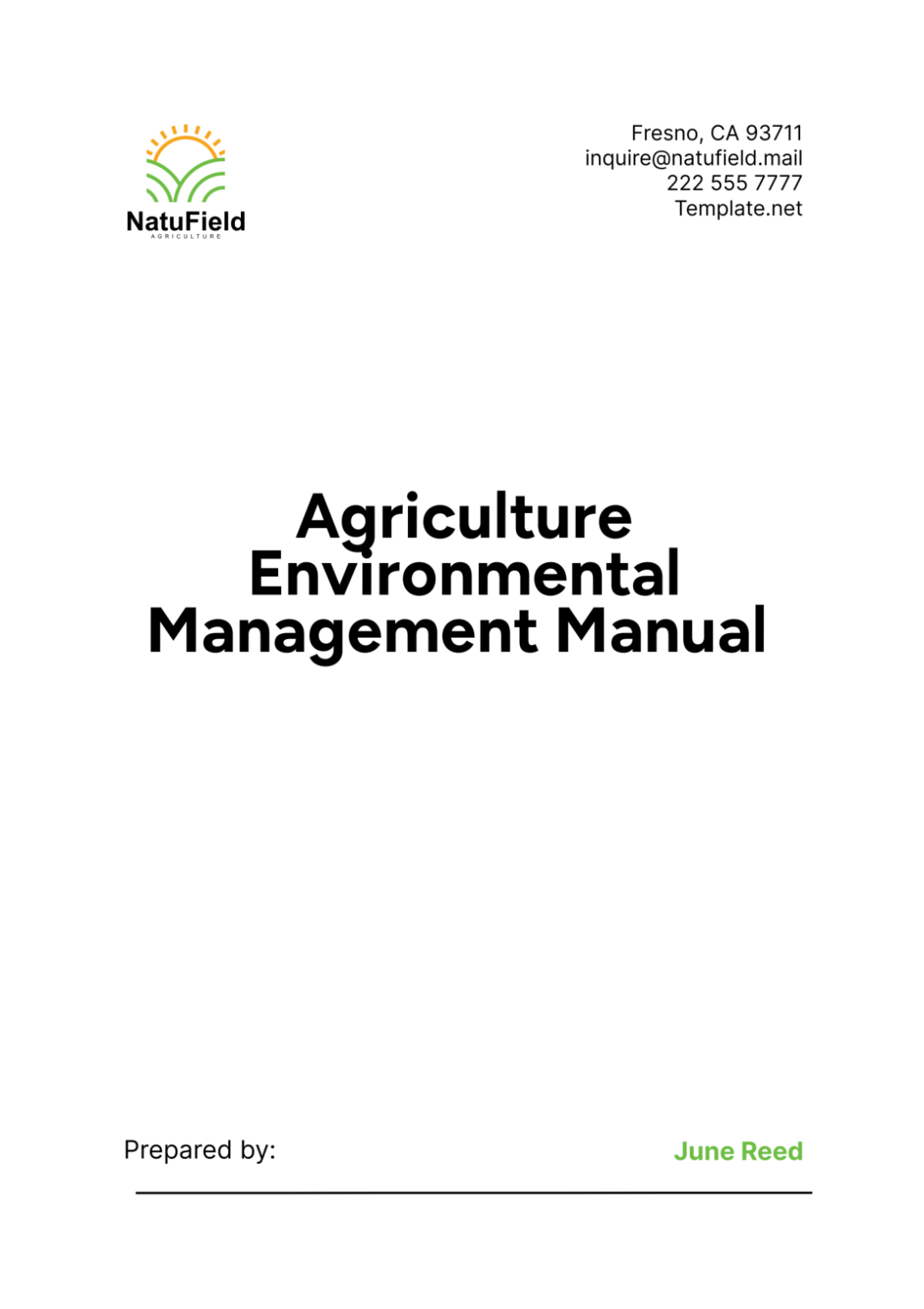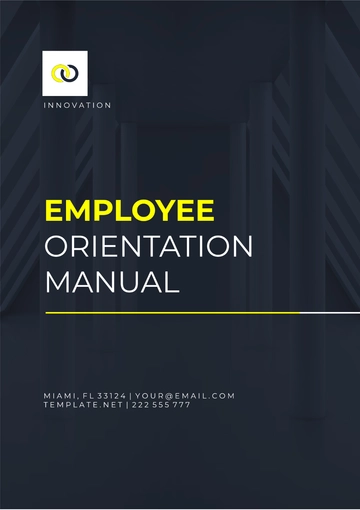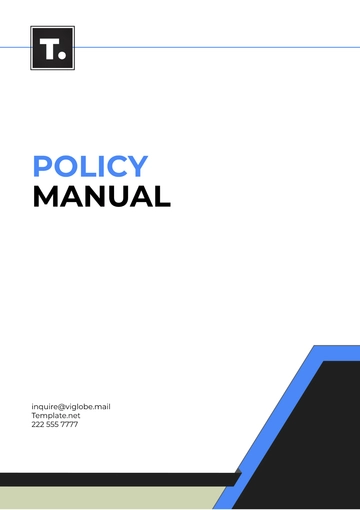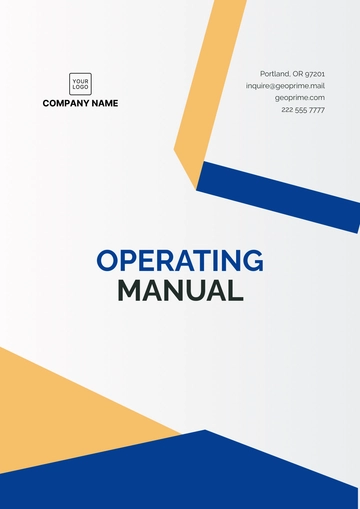Free Agriculture Environmental Management Manual

I. Overview
A. Purpose of the Manual
The purpose of the Agriculture Environmental Management Manual is to provide comprehensive guidelines and practices to ensure sustainable and environmentally responsible agricultural operations at [Your Company Name]. This manual aims to educate and guide farmers, agricultural managers, and other stakeholders in implementing effective environmental management strategies that align with regulatory requirements and best practices in the industry.
B. Importance of Environmental Management in Agriculture
Environmental management in agriculture is crucial for maintaining the health and productivity of agricultural lands, preserving natural resources, and minimizing the negative impacts of farming activities on the environment. Effective environmental management helps in reducing soil degradation, conserving water, enhancing biodiversity, and mitigating the effects of climate change. By adopting sustainable practices, [Your Company Name] can contribute to long-term agricultural productivity, economic viability, and environmental stewardship.
C. Scope and Applicability
This manual is applicable to all agricultural operations and practices conducted by [Your Company Name]. It covers a wide range of environmental aspects, including soil and water management, waste management, biodiversity conservation, energy use, and climate change adaptation. The guidelines provided are intended for use by farmers, agricultural managers, and other stakeholders involved in the planning, implementation, and monitoring of agricultural activities.
II. Regulatory Framework
A. International Regulations
International regulations play a vital role in shaping the environmental management practices in agriculture. Agreements such as the Paris Agreement on Climate Change and the Convention on Biological Diversity provide a framework for countries to implement measures that reduce greenhouse gas emissions, protect biodiversity, and promote sustainable land use. [Your Company Name] is committed to adhering to these international agreements and incorporating their principles into our agricultural practices.
B. National and Local Regulations
National and local regulations provide specific guidelines and requirements for environmental management in agriculture. These regulations may include laws related to water usage, waste management, pesticide application, and land conservation. [Your Company Name] ensures compliance with all relevant national and local regulations by regularly reviewing our practices and updating our procedures to meet the latest standards.
C. Compliance Requirements
Compliance with regulatory requirements is essential for maintaining the legal and ethical integrity of agricultural operations. [Your Company Name] has established a compliance program that includes regular audits, training sessions, and documentation to ensure all activities meet regulatory standards. By adhering to these requirements, we can avoid legal penalties, reduce environmental impact, and promote sustainable farming practices.
III. Environmental Impact Assessment
A. Identifying Potential Environmental Impacts
Environmental impact assessment (EIA) is a systematic process used to identify and evaluate the potential environmental effects of proposed agricultural activities. At [Your Company Name], we conduct EIAs to assess the potential impacts on soil, water, air, and biodiversity. This process involves data collection, site analysis, and stakeholder consultations to identify potential risks and develop mitigation strategies.
B. Conducting Environmental Impact Assessments
The EIA process at [Your Company Name] involves several steps, including:
Screening: Determining whether a proposed activity requires an EIA.
Scoping: Identifying the key environmental issues and potential impacts to be studied.
Impact Analysis: Assessing the magnitude and significance of potential impacts.
Mitigation Planning: Developing measures to avoid, reduce, or offset adverse impacts.
Reporting: Documenting the findings and recommendations in an EIA report.
C. Mitigation Measures
Mitigation measures are actions taken to prevent, reduce, or compensate for negative environmental impacts. At [Your Company Name], we implement a range of mitigation measures, including:
Soil Conservation: Using techniques such as contour plowing, terracing, and cover cropping to prevent soil erosion.
Water Management: Implementing efficient irrigation systems and rainwater harvesting to conserve water resources.
Biodiversity Protection: Creating buffer zones and wildlife corridors to preserve natural habitats.
IV. Sustainable Farming Practices
A. Soil Management
Soil Conservation Techniques
Soil conservation is essential for maintaining soil health and preventing degradation. [Your Company Name] employs various soil conservation techniques to protect and enhance soil quality. These techniques include:
Contour Plowing: Plowing along the contour lines of the land to reduce soil erosion and runoff.
Terracing: Creating stepped terraces on slopes to slow down water flow and prevent soil erosion.
Cover Cropping: Planting cover crops during off-seasons to protect the soil from erosion, improve soil structure, and enhance nutrient cycling.
Soil Fertility Management
Maintaining soil fertility is crucial for sustainable crop production. [Your Company Name] adopts integrated soil fertility management practices, which include:
Organic Amendments: Applying compost, manure, and other organic materials to improve soil fertility and structure.
Crop Rotation: Rotating different crops on the same land to break pest cycles, improve soil health, and enhance nutrient availability.
Soil Testing: Regularly testing soil to monitor nutrient levels and adjust fertilization practices accordingly.
B. Water Management
Efficient Irrigation Practices
Efficient irrigation practices help conserve water and improve crop yields. [Your Company Name] implements advanced irrigation systems and techniques, such as:
Drip Irrigation: Delivering water directly to the root zone of plants through a network of tubes, reducing water wastage and evaporation.
Sprinkler Irrigation: Using sprinklers to distribute water evenly across the field, ensuring optimal soil moisture levels.
Scheduling Irrigation: Using soil moisture sensors and weather data to schedule irrigation based on crop water needs and environmental conditions.
Water Conservation Strategies
Water conservation is vital for sustainable agriculture. [Your Company Name] adopts various strategies to conserve water resources, including:
Rainwater Harvesting: Collecting and storing rainwater for irrigation and other agricultural uses.
Mulching: Applying organic or inorganic mulch to the soil surface to reduce evaporation, suppress weeds, and maintain soil moisture.
Efficient Water Use: Implementing water-saving technologies and practices, such as precision irrigation and deficit irrigation, to optimize water use efficiency.
C. Crop Management
Integrated Pest Management
Integrated Pest Management (IPM) is an ecological approach to pest control that combines biological, cultural, physical, and chemical methods. [Your Company Name] follows IPM principles to manage pests effectively and sustainably. Our IPM practices include:
Biological Control: Using natural predators, parasites, and pathogens to control pest populations.
Cultural Practices: Implementing crop rotation, intercropping, and planting pest-resistant varieties to reduce pest incidence.
Mechanical Control: Using traps, barriers, and manual removal to manage pests.
Chemical Control: Applying pesticides judiciously and only when necessary, following recommended guidelines to minimize environmental impact.
Crop Rotation and Diversification
Crop rotation and diversification are essential practices for maintaining soil health and reducing pest and disease pressure. [Your Company Name] promotes the following strategies:
Crop Rotation: Alternating different crops on the same land in a planned sequence to improve soil fertility, reduce pest buildup, and enhance crop yields.
Diversification: Planting a variety of crops within a farming system to increase biodiversity, spread economic risk, and improve resilience to environmental changes.
V. Waste Management
A. Types of Agricultural Waste
Agricultural waste includes various types of waste generated from farming activities, such as:
Crop Residues: Stalks, leaves, and other plant parts left after harvesting.
Animal Manure: Waste produced by livestock, including feces and urine.
Chemical Containers: Empty containers of pesticides, herbicides, and fertilizers.
Plastic Waste: Used plastic mulch, drip tapes, and packaging materials.
B. Waste Reduction Strategies
Reducing agricultural waste is crucial for minimizing environmental impact and improving resource efficiency. [Your Company Name] employs several waste reduction strategies, such as:
Crop Residue Management: Incorporating crop residues into the soil as organic matter or using them as animal feed or biofuel.
Manure Management: Composting animal manure to produce organic fertilizer and reduce greenhouse gas emissions.
Chemical Management: Properly storing, handling, and disposing of chemical containers to prevent contamination and reduce waste.
C. Waste Recycling and Disposal
Recycling and proper disposal of agricultural waste are essential for sustainable waste management. [Your Company Name] follows best practices for recycling and disposing of waste, including:
Composting: Turning organic waste into compost to improve soil fertility and structure.
Recycling Plastic Waste: Collecting and recycling used plastic materials to reduce pollution and promote resource efficiency.
Safe Disposal: Following regulatory guidelines for the safe disposal of hazardous waste, such as chemical containers and expired pesticides.
VI. Biodiversity Conservation
A. Importance of Biodiversity in Agriculture
Biodiversity is vital for the health and productivity of agricultural ecosystems. It provides essential services, such as pollination, pest control, and nutrient cycling, which support crop production and resilience. Conserving biodiversity helps maintain ecosystem balance, enhance agricultural sustainability, and protect the genetic diversity of crops and livestock.
B. Strategies for Biodiversity Conservation
[Your Company Name] implements various strategies to conserve biodiversity on agricultural lands, including:
Habitat Conservation: Protecting and restoring natural habitats, such as wetlands, forests, and grasslands, to support wildlife and enhance ecosystem services.
Agroforestry: Integrating trees and shrubs into agricultural landscapes to provide habitat for wildlife, improve soil health, and enhance carbon sequestration.
Buffer Zones: Establishing buffer zones around fields and waterways to protect natural habitats and reduce the impact of agricultural activities on the environment.
C. Monitoring and Reporting
Monitoring and reporting biodiversity is essential for assessing the effectiveness of conservation efforts and making informed management decisions. [Your Company Name] has established a biodiversity monitoring program that includes:
Biodiversity Surveys: Conducting regular surveys to assess the presence and abundance of plant and animal species on agricultural lands.
Habitat Assessments: Evaluating the condition and extent of natural habitats to identify conservation priorities and track changes over time.
Reporting: Documenting and reporting biodiversity data to stakeholders, regulatory agencies, and conservation organizations to demonstrate our commitment to biodiversity conservation and compliance with regulatory requirements.
VII. Energy Management
A. Energy Use in Agriculture
Agriculture is an energy-intensive sector that relies heavily on various forms of energy, including fossil fuels, electricity, and renewable sources. Energy is essential for powering machinery, irrigation systems, processing facilities, and transportation. At [Your Company Name], we recognize the importance of efficient energy use to reduce operational costs, minimize environmental impact, and promote sustainable farming practices. By optimizing energy consumption, we can enhance productivity and contribute to environmental conservation.
B. Renewable Energy Sources
Renewable energy sources offer a sustainable alternative to conventional fossil fuels. They help reduce greenhouse gas emissions, lower energy costs, and promote energy independence. [Your Company Name] is committed to integrating renewable energy into our agricultural operations. Some of the renewable energy sources we utilize include:
Solar Power: Installing solar panels to generate electricity for powering irrigation systems, machinery, and processing facilities.
Wind Energy: Utilizing wind turbines to harness wind power for electricity generation, particularly in regions with high wind potential.
Biomass Energy: Converting agricultural waste, such as crop residues and animal manure, into bioenergy through processes like anaerobic digestion and combustion.
C. Energy Efficiency Measures
Implementing energy efficiency measures is crucial for reducing energy consumption and enhancing sustainability. At [Your Company Name], we adopt various strategies to improve energy efficiency, including:
Energy Audits: Conducting regular energy audits to identify areas of high energy consumption and opportunities for improvement.
Efficient Equipment: Investing in energy-efficient machinery and equipment that consume less power while maintaining high performance.
Irrigation Optimization: Using advanced irrigation technologies, such as drip and sprinkler systems, to minimize water and energy use.
Building Insulation: Improving the insulation of buildings and facilities to reduce heating and cooling energy requirements.
VIII. Climate Change Adaptation and Mitigation
A. Impact of Climate Change on Agriculture
Climate change poses significant challenges to agricultural production, affecting crop yields, livestock health, and water availability. Changes in temperature, precipitation patterns, and the frequency of extreme weather events can lead to increased pest and disease pressure, soil degradation, and reduced water resources. [Your Company Name] acknowledges the importance of addressing climate change to ensure the resilience and sustainability of our agricultural operations.
B. Adaptation Strategies
To cope with the adverse effects of climate change, [Your Company Name] implements various adaptation strategies, such as:
Diversified Cropping Systems: Growing a variety of crops to spread risk and increase resilience to climate variability.
Drought-Resistant Varieties: Developing and planting crop varieties that are more tolerant to drought and extreme weather conditions.
Improved Water Management: Enhancing water conservation and irrigation practices to cope with changing precipitation patterns and water scarcity.
Agroforestry: Integrating trees and shrubs into agricultural systems to provide shade, reduce wind erosion, and improve microclimate conditions.
C. Mitigation Measures
Mitigating the impact of agriculture on climate change involves reducing greenhouse gas emissions and enhancing carbon sequestration. [Your Company Name] adopts several mitigation measures, including:
Reduced Tillage: Implementing conservation tillage practices to minimize soil disturbance, reduce carbon emissions, and enhance soil carbon storage.
Nutrient Management: Optimizing the use of fertilizers to reduce nitrous oxide emissions and improve nutrient use efficiency.
Afforestation and Reforestation: Planting trees and restoring degraded lands to sequester carbon and enhance biodiversity.
Methane Management: Implementing practices such as improved manure management and feed optimization to reduce methane emissions from livestock.
IX. Environmental Monitoring and Reporting
A. Monitoring Environmental Performance
Monitoring environmental performance is essential for assessing the effectiveness of environmental management practices and ensuring compliance with regulatory requirements. [Your Company Name] has established a comprehensive environmental monitoring program that includes regular assessments of soil, water, air, and biodiversity. This program helps us identify potential environmental issues, track progress, and make informed decisions to improve our practices.
B. Reporting Requirements
Accurate and transparent reporting of environmental performance is crucial for maintaining stakeholder trust and demonstrating compliance with regulatory standards. [Your Company Name] follows a systematic reporting process that involves:
Data Collection: Gathering relevant environmental data through field measurements, laboratory analyses, and remote sensing technologies.
Data Analysis: Analyzing the collected data to identify trends, assess performance, and determine areas for improvement.
Documentation: Preparing detailed reports that document our environmental performance, mitigation measures, and compliance status.
Stakeholder Communication: Sharing our environmental performance reports with stakeholders, including regulatory agencies, customers, and the local community, to promote transparency and accountability.
C. Continuous Improvement
Continuous improvement is a key principle of environmental management at [Your Company Name]. We are committed to regularly reviewing and updating our practices to enhance environmental performance. This involves:
Performance Reviews: Conduct regular reviews of our environmental performance to identify successes and areas for improvement.
Stakeholder Feedback: Seeking feedback from stakeholders to understand their concerns and expectations regarding our environmental practices.
Innovation and Research: Investing in research and innovation to develop and adopt new technologies and practices that improve sustainability.
Training and Capacity Building: Providing ongoing training and capacity-building programs for our employees to ensure they have the knowledge and skills to implement best environmental management practices.
X. Training and Awareness
A. Importance of Training in Environmental Management
Training is a critical component of effective environmental management. It ensures that all employees understand the importance of environmental stewardship and are equipped with the knowledge and skills to implement sustainable practices. [Your Company Name] places a strong emphasis on training and capacity building to foster a culture of environmental responsibility.
B. Training Programs and Workshops
[Your Company Name] offers a range of training programs and workshops to enhance the environmental management capabilities of our employees. These programs cover various topics, including:
Environmental Regulations: Training on relevant national and local environmental regulations to ensure compliance and avoid legal penalties.
Sustainable Farming Practices: Workshops on soil conservation, water management, waste reduction, and biodiversity conservation to promote sustainable agriculture.
Energy Efficiency: Training on energy-efficient technologies and practices to reduce energy consumption and operational costs.
Climate Change Adaptation: Workshops on climate change impacts, adaptation strategies, and mitigation measures to build resilience and reduce greenhouse gas emissions.
C. Promoting Environmental Awareness among Farmers
Raising environmental awareness among farmers is essential for the successful implementation of sustainable practices. [Your Company Name] engages in various activities to promote environmental awareness, including:
Community Outreach: Organizing community outreach programs to educate farmers and the local community about the importance of environmental management.
Information Dissemination: Distributing educational materials, such as brochures, newsletters, and posters, to provide information on best environmental practices.
Demonstration Projects: Implementing demonstration projects on farms to showcase successful environmental management practices and their benefits.
XI. Case Studies and Best Practices
A. Successful Environmental Management Case Studies
Case studies of successful environmental management practices provide valuable insights and inspiration for continuous improvement. [Your Company Name] documents and shares case studies of innovative and effective practices implemented on our farms. These case studies highlight the challenges faced, solutions adopted, and the positive outcomes achieved. By learning from these experiences, we can replicate and scale up successful practices across our operations.
B. Best Practices in Agriculture
Adopting best practices in agriculture is essential for achieving sustainable production and environmental stewardship. [Your Company Name] identifies and promotes best practices that enhance productivity, conserve resources, and protect the environment. Some of the best practices we implement include:
Precision Agriculture: Using advanced technologies, such as GPS and remote sensing, to optimize inputs, improve efficiency, and reduce environmental impact.
Conservation Agriculture: Practicing minimum tillage, maintaining soil cover, and diversifying crops to enhance soil health and productivity.
Agroecology: Applying ecological principles to farming systems to create resilient and sustainable agricultural landscapes.
C. Lessons Learned
Reflecting on the lessons learned from our environmental management experiences helps us continuously improve and innovate. [Your Company Name] regularly reviews and documents lessons learned from our projects and initiatives. Key lessons include the importance of stakeholder engagement, the need for adaptive management, and the value of integrating traditional knowledge with modern practices. By incorporating these lessons into our future planning and decision-making, we can enhance our environmental performance and achieve long-term sustainability.
XII. References and Resources
A. Key References
Access to reliable references is crucial for informed decision-making and continuous improvement in environmental management. [Your Company Name] maintains a comprehensive list of key references, including:
Scientific Literature: Research articles, journals, and books on environmental management, sustainable agriculture, and climate change.
Regulatory Documents: National and local regulations, guidelines, and standards related to environmental management in agriculture.
Industry Reports: Publications from agricultural organizations, research institutions, and industry bodies that provide insights into best practices and emerging trends.
B. Best Practices in Agriculture
Practice | Description |
|---|---|
Precision Agriculture | Using advanced technologies, such as GPS and remote sensing, to optimize inputs, improve efficiency, and reduce environmental impact. |
Conservation Agriculture | Practicing minimum tillage, maintaining soil cover, and diversifying crops to enhance soil health and productivity. |
Agroecology | Applying ecological principles to farming systems to create resilient and sustainable agricultural landscapes. |
C. Contact Information for Further Assistance
For further assistance and support on environmental management, [Your Company Name] provides contact information for our environmental management team. This team includes experts in various fields, such as soil science, water management, energy efficiency, and biodiversity conservation. Employees and stakeholders can reach out to the team for guidance, technical assistance, and additional information.
Contact Information:
Environmental Manager: [Employee Name]
Email: [Your Company Email]
Phone: [Your Company Number]
Address: [Your Company Address]
By utilizing the references and resources provided, employees and stakeholders can stay informed, build their capacity, and contribute to the successful implementation of our environmental management practices.
- 100% Customizable, free editor
- Access 1 Million+ Templates, photo’s & graphics
- Download or share as a template
- Click and replace photos, graphics, text, backgrounds
- Resize, crop, AI write & more
- Access advanced editor
Create comprehensive environmental management guides with Template.net's customizable and editable Agriculture Environmental Management Manual Template. Leverage the AI Editor Tool for detailed and effective documentation. This user-friendly template promotes sustainable practices, enhancing environmental responsibility and compliance in your agricultural business.





























